Making a step up from the League One to the Championship is never easy, especially with the fact that several names in the league are getting stronger by securing the service of many well-known players. But in recent years, there are some teams who managed to close the distance of that gap either through their tactics or the ability of the whole squad.
We have seen the likes of Sheffield United and Millwall making progress in the 2017-18 season and the former even secured promotion the season after. Then, Charlton Athletic have had a decent start to this season as they position themselves inside the promotion-chasing group on several occasions. Still, what happened to the other two teams that went up along with Charlton? Barnsley are still struggling as they currently place last in the league table and have just seen manager Daniel Stendel leave the club to be replaced by former Wolfsberger AC manager Gerhard Struber.
For Luton Town, though, they have a strong start to the season but then saw a dip in form and currently, they are one point away from the relegation spots. Looking at their stats, though, the record of 22 goals seems like pretty impressive for a newcomer like them and even makes them the second-highest goal-scoring team among the bottom half of the table, just below Cardiff’s record of 23 goals. In contrast, with 30 goals conceded from the start of the season, they are also the second-highest team in terms of conceding alongside Queens Park Rangers and only better than Barnsley (33 goals conceded).
This tactical analysis scout report will provide an analysis of the contrast between Luton Town’s xG and xGA stats. Meanwhile, using statistics and footage, we will point out the strengths and weaknesses of Graeme Jones’ tactics.
Formation
Even from the beginning stage of the season, the former West Bromwich Albion assistant manager already showed his intention of keeping the principles that helped the team secured back-to-back promotions under Nathan Jones and Mick Harford. Lining up in a 4-1-2-1-2, Luton focus on playing through the central area more often while still occupying both flanks using the flexible movements of the strikers and the overlapping runs of the wing-backs.
But as the season goes by, Jones also implements several tactical changes which allow the team to adapt to the Championship more easily. Firstly, by using either Jacob Butterfield, Martin Cranie or Alan Sheehan as a single pivot, it is possible for the team to create a back-three during their build-up process. Usually, both centre-backs will drift wide into the half-spaces to allow the defensive midfielder to slot into the central area, similar to how a half-back plays.
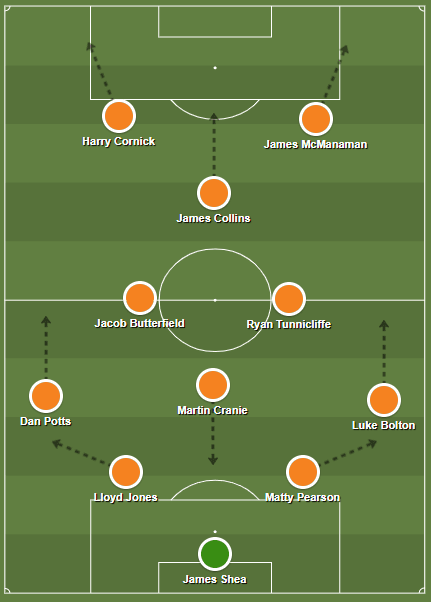
Secondly, Graeme Jones keeps the use of the striker who tends to drift wide more often, which is used effectively under Nathan Jones and Mick Harford. In Harry Cornick, he has a player who knows the system well and has thrived this season with five goals and two assists to his name. The arrival of Callum McManaman, a natural winger, also gives Jones a flexible rotational choice as he can employ both on the field, similar to how he lined his side up against Reading.
This strategy allows the attacking midfielder below them, in this case, is either James Collins or Izzy Brown, to attack the central area. They will make late runs into the box to turn up at the end of crosses or linking up with the midfielders and drive forward on their own. Combines the two most noticeable changes with the familiar principles, it is easy to point out that Luton play in a 3-4-3 formation on many occasions this season.
Overperforming their xG
As mentioned, Luton have scored 22 goals up until before matchday seventeen of the Championship, which is an impressive record for a newly-promoted team. Besides from Cornick and Collins’ records of five goals respectively, the goals are spread quite equally among the team, which shows the fact that every player has the chance to score in each match. According to the numbers, they are even outperforming their total expected goals, which stands at 16.13 goals. To understand how Luton are doing better than the numbers expected them to, it is worth looking at their attacking style of play.
When in possession, the team tend to play out from the back using the passing ability of their defenders. Having a back-three with a single pivot dropping deep allow Luton to create one passing triangle during the build-up process. Furthermore, with two central midfielders occasionally move close to the triangle, it is viable to link up with them and form a passing block inside their half.
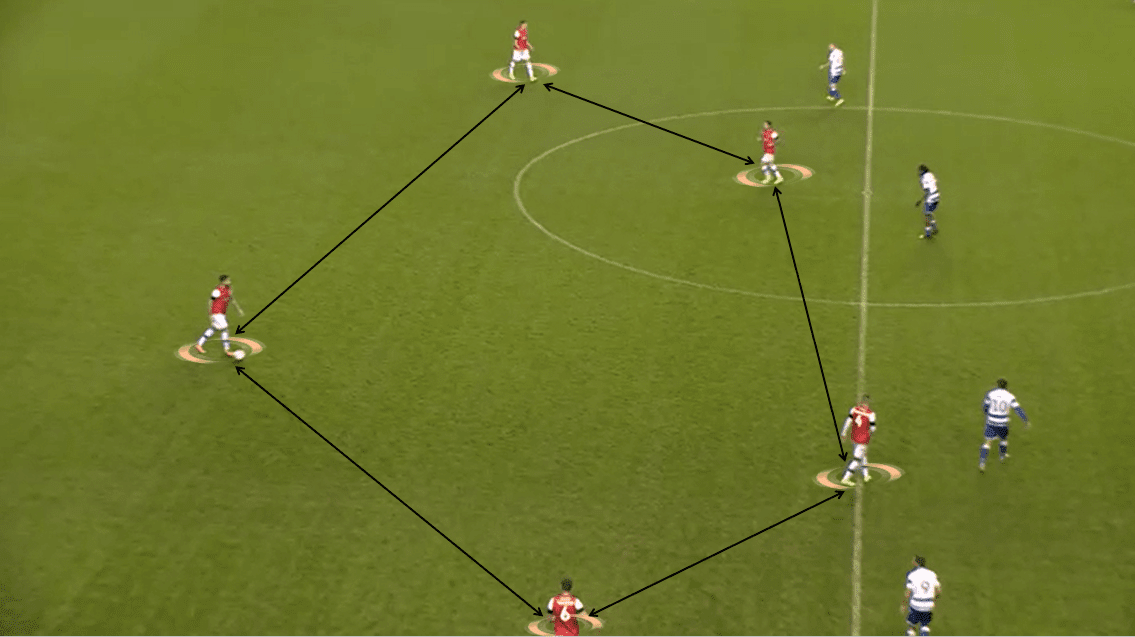
This is an effective strategy when playing against teams who usually press high and employ aggressive pressure to recover possession. The players will be able to use the third-man concept under pressure to circulate the ball out of the overloaded area while still progressing it up the field.
To link up with the attackers up front, the players involved in the build-up process opt to put the responsibility of driving forward with the ball on one of the central midfielders. Usually, it would be either Pelly-Ruddock Mpanzu or Andrew Shinnie, depending on who receives the nod from the manager to start in his starting lineup. They both are dynamic midfielders who tend to roam from their positions on many occasions, especially Mpanzu. Statistically speaking, Mpanzu is currently leading among the mentioned three central midfielders in terms of dribbling with 5.05 dribbles with Shinnie then follows up with 3.1 dribbles per 90 minutes.
Surprisingly, one of the responsibilities that the centre-backs also receive is dribbling with the ball, amid the fact that this doesn’t happen too often. While, as mentioned, linking up with the players up front is the job that is usually for the midfielders, they can also burst forward with the ball at their feet and then make penetrative passes on their own.
In the role of a roaming playmaker, not only can Shinnie roam from his position to receive the ball in a more flexible way, but he is also a competent passer who makes forward and penetrative passes to progress the team’s attack. As Luton fans like to refer him as “Shinniesta”, he plays a key role in linking up the play by picking up possession across the pitch then driving forward into the final third. There, Shinnie will scan the area looking for potential receivers who position themselves in a good position, a through ball or lofted pass will be made to allow them to enter the 16-yard box, similar to the shot below that led to Collins’ goal against Queens Park Rangers.
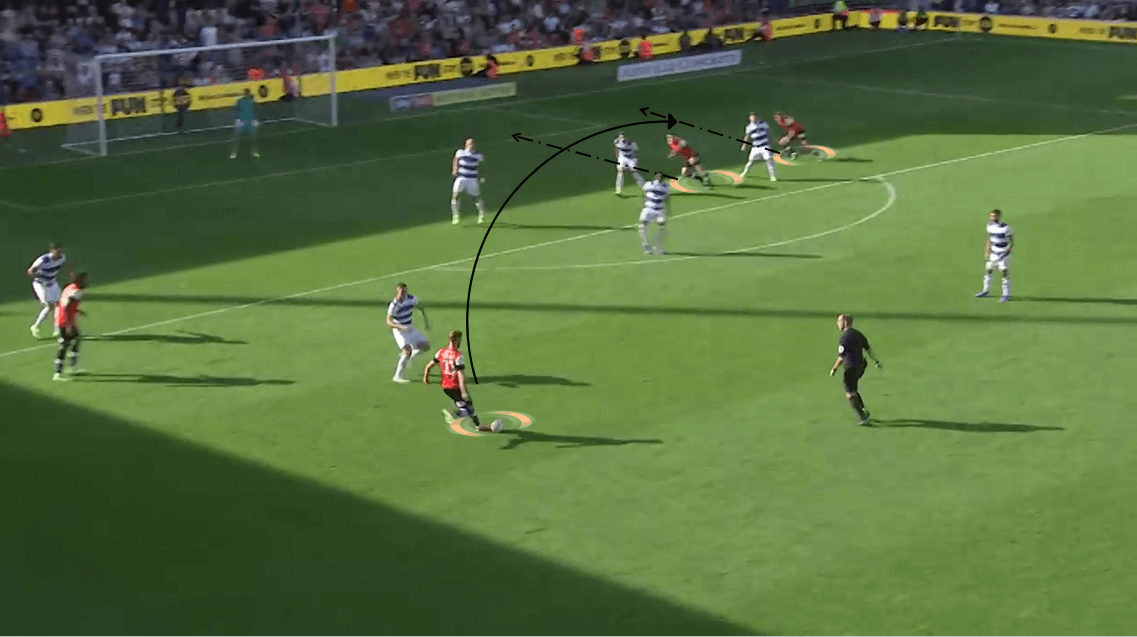
Another option that Luton defenders also make the most out of is making long passes towards the attackers. From the mentioned passing block, they will pick out teammates who are positioned in pockets of space and ready to receive the ball through a long-ranged pass which helps them continue their progressive run. But with only 39.74 long balls made per 90 minutes, going direct doesn’t seem to be the option that the likes of Matty Pearson, Sonny Bradley or Lloyd Jones opt to go with on most occasions.
Speaking of through passes, that type of pass is usually seen in Luton’s counter-attacks as it helps the attackers to attack the space behind the opposition’s defensive line. In a quick break, the players also opt to circulate the ball in a quick fashion while encouraging the attackers to position themselves in pockets of space.
Using passing triangles created among the midfielders, they will get the ball to the attacking midfielder and allow him to play a through ball into the run of one of the attackers. In the shot below, Cornick was the player who turned up at the end of Brown’s pass as the former Bournemouth player attempted to attack the space behind Bristol City’s defensive line using his pace.
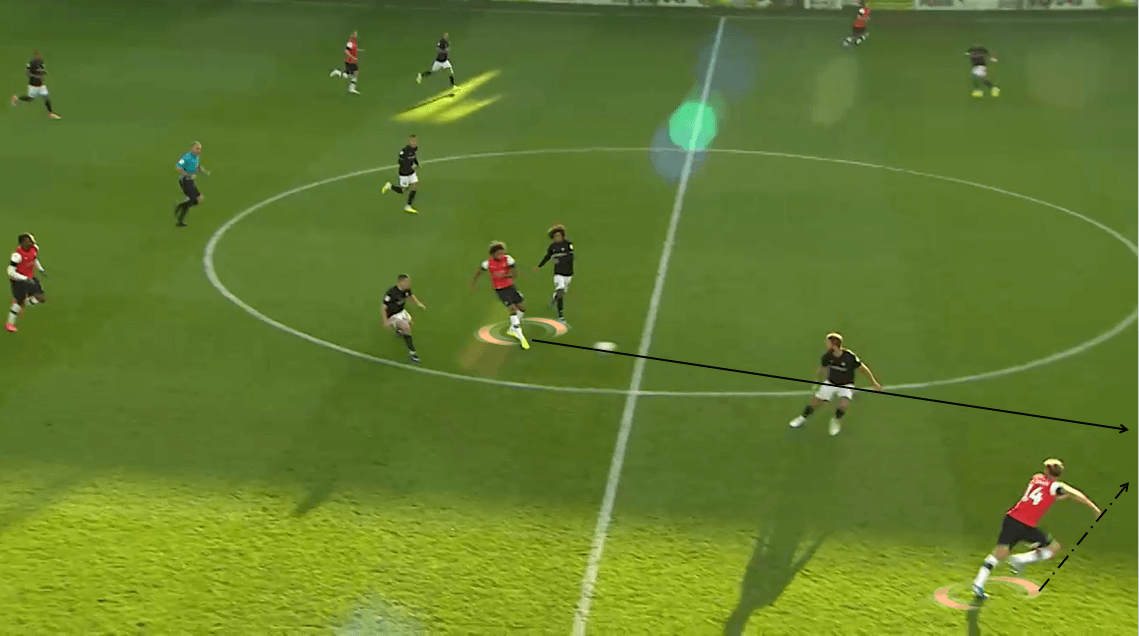
As a wing-oriented team, it is no surprise to see Luton exploit both wings on many occasions when they manage to get the ball into the final third. In Dan Potts and James Bree, Jones has two quality wing-backs who are good in making overlapping runs up the pitch to join the attack. They can occupy the wide-areas when the wingers decide to stay inside and form a narrow front three inside the box. From either flank, crosses will be sent into the box in an attempt to find attackers who are positioning themselves inside pockets of space.
This is the main attacking method for Luton as they have scored nine goals from crosses. Furthermore, they are also lethal from converting corners into goals with the physicality of their centre-backs. This season, Pearson has found the net twice from his teammates’ deliveries from either corner of the opposition’s half. Cranie also opened his account against Middlesbrough and Bradley scored a stunning volley after picking up the clearance in the same match.
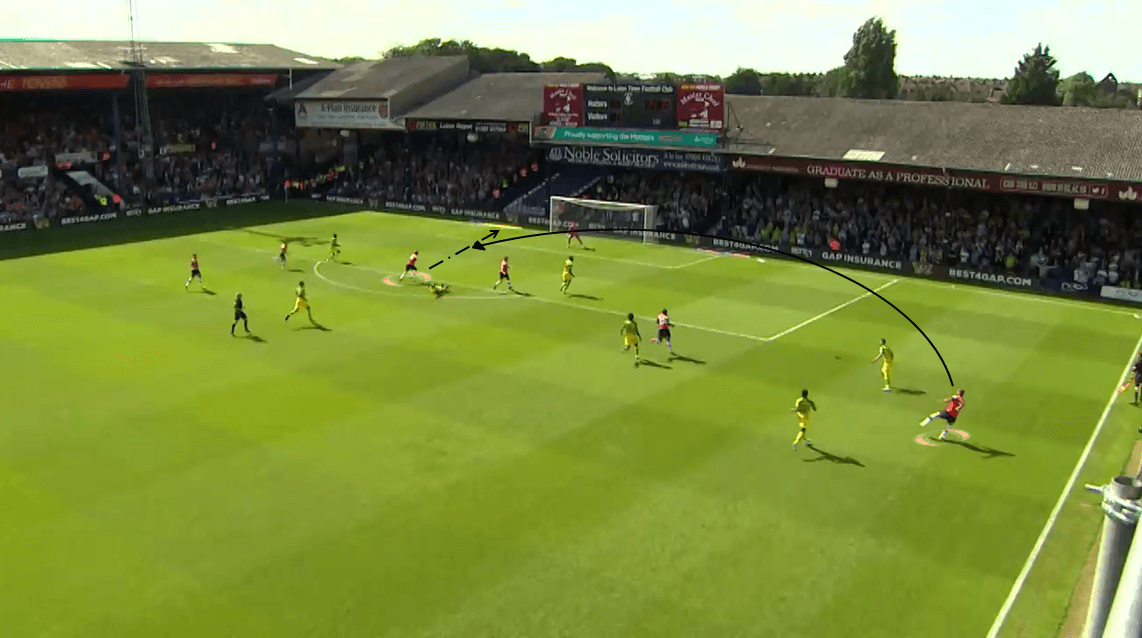
In my previous two articles on Nathan Jones’ Luton Town and a review on the team’s back-to-back promotion journey, I have emphasised the importance of Cornick’s role in the team’s play. This season isn’t an exception, either. Theoretically, he is employed as a striker alongside Collins in most of the time but is given the license to drift wide to occupy either the half-space or the flank.
By doing so, he creates space for the attacking midfielder from below to enter and forming the front three when approaching the 16-yard box. At the same time, the opposite scenario can also happen with the wing-backs turn inverted as they tuck inside and enter the half-spaces while the wingers drift wide, similar to Potts in the situation below against Reading.
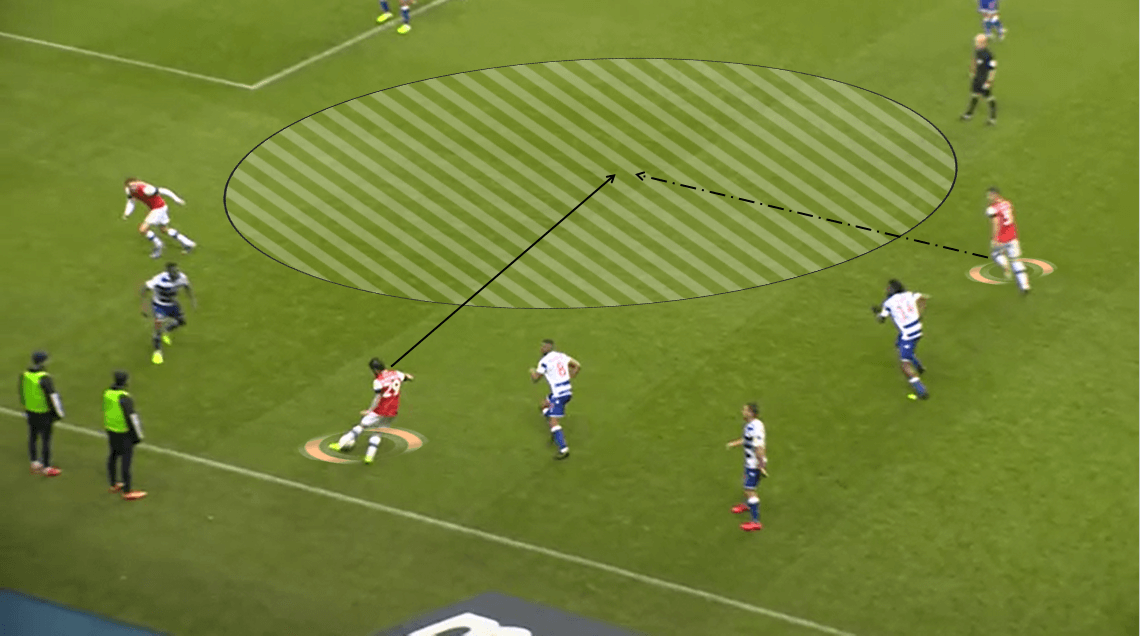
Underperforming their xGA
As good as Luton are in terms of converting their chances into goals, there are reasons behind the fact that they are still struggling to rise up the table this season. Dropping points is one of the traits that can be easily seen as they tend to be in the back foot in most of the matches and have to chase the opponent for a glimpse of points. And due to the fact that they have many major problems at their end of the pitch, it makes the challenge of getting back into the match more difficult, which contributes much to their record of thirty goals conceded and doing much worse than the numbers expected them to (their total xGA is 24.12). Surprisingly, though, most of their strengths being mentioned above now turned into their weaknesses.
A noticeable problem that Luton players usually show is leaving gaps unoccupied. In the shot below against Nottingham Forest, there are three players positioned themselves in the left-hand side from Yuri Ribeiro’s perspective. They focused on suffocating that side of the pitch while eliminating the two possible passing options out wide. Instead, their body orientation and positioning created a huge gap with no players managed to fill in. This allowed Ribeiro to find Lewis Grabban with a through ball, amid the fact that both Bree and Bradley also approached the former Aston Villa striker attempting to intercept the pass.
As Cornick, Tunnicliffe and Cranie (in the order from the player closest to Ribeiro) focused their attention on the two Nottingham Forest players out wide, they oriented their body towards them looking to intercept a long ball into that area. No one was prepared for Ribeiro’s pass and they weren’t able to act when the pass was made. Cranie’s positioning could have saved the situation as he was able to keep his body oriented towards the Ribeiro’s left-hand side while moving slightly to the right and filled in that gap.
When Grabban received the ball, Bree and Bradley decided to take on a more active move to both jump in and tackled him. The former Huddersfield defender could act as a cover for them while still able to recover possession after Grabban’s touch to bypass Bree. Instead, he decided to stick with the group and not even involved in the duel along with his teammates.
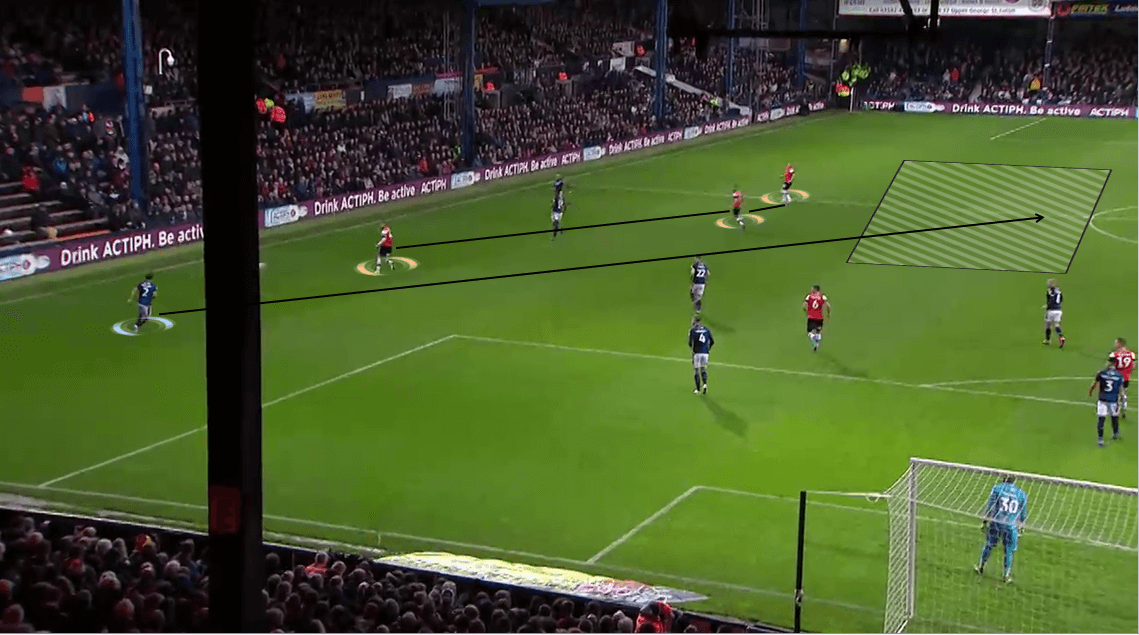
Another factor that also relate to their spatial managing problem is marking. When Luton are out of possession, the players tend to press the opposition quite aggressively with the aim of recovering the ball, especially inside their half. High up the pitch, they also maintain their press, but instead, keeping it more conservative and allow the opponent’s defenders circulate the ball among themselves.
The press is proved to be effective as they manage to recover the ball quite often in the middle part of the pitch. But their strategy also comes with a setback, which is shown in the situation below against Middlesbrough. The players are usually found creating overloads across the pitch or at least preventing the opposition from winning numerical superiority in certain parts. When they attempt to do so, it is required that the whole defensive shape to shift across to fill in gaps in between the defenders.
In several occasions, which similar to the situation below, the lack of understanding hinders the process of shifting towards the overloaded area. This will create gaps inside and on the edge of their 16-yard box and it can invite the opposition’s attackers to move into for continuing their team’s attack.
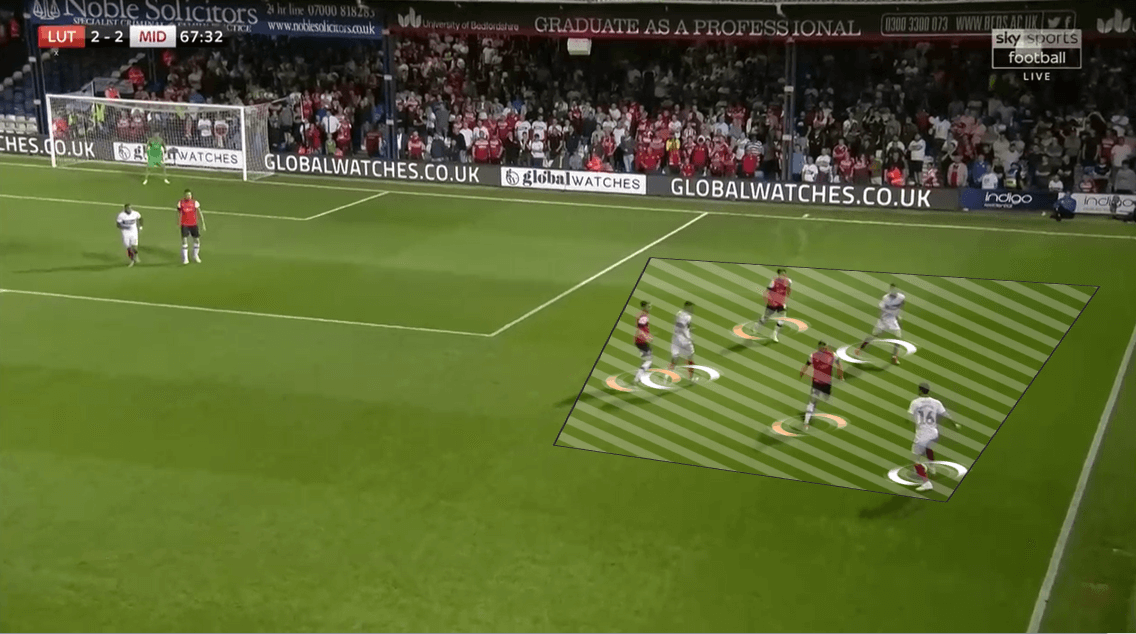
In the match against Millwall, a similar scenario happened which led to Tom Bradshaw’s opening goal of the game. When the winger controlled possession, two Luton players attempted to move out from their positions and pressed him. While that strategy remained efficient for the home side in this situation, their conservative press allowed the Millwall player to make a pass towards Jed Wallace, who already positioned himself in free space.
Although another two Luton defenders approached him, they weren’t able to stop the shot and forced Sluga to make the save. The Croatian goalkeeper kept the first attempt out but Bradshaw’s rebound was out of his reach and he stood no chance from preventing Millwall’s opening goal. Speaking of Sluga himself, he has had an abysmal start to his career in the Championship as he contributes to a total of five individual errors that either directly or indirectly lead to goals for their opponents.
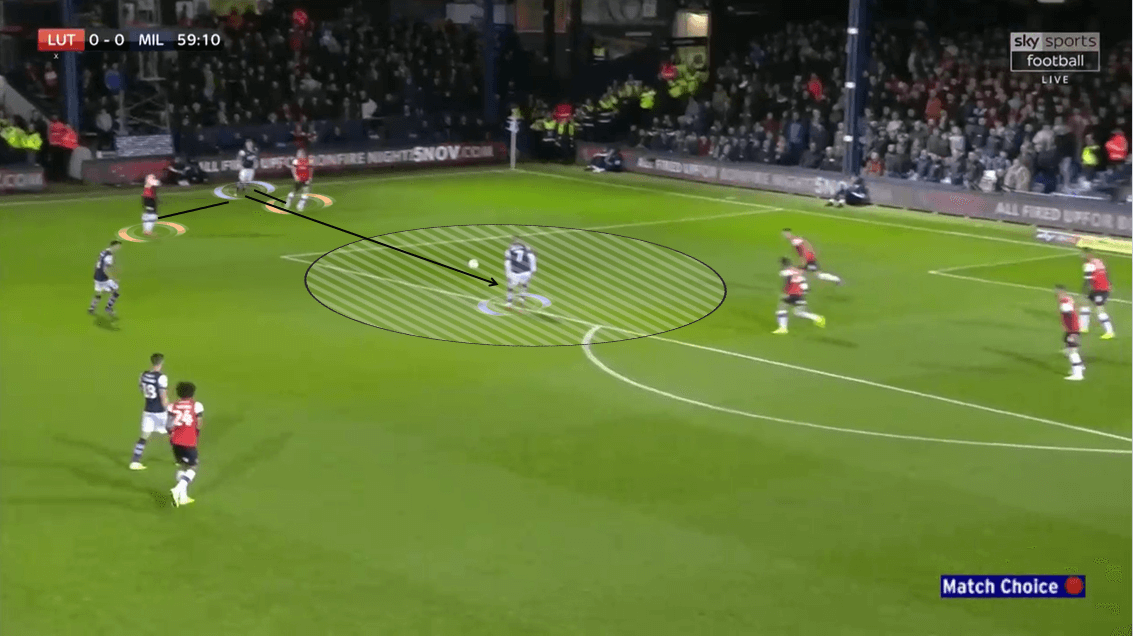
One of the scenarios that perfectly sum up the two mentioned problems is Eberechi Eze’s opening goal in Queens Park Rangers’ 3-2 win over Luton. Another trait that can be spotted from this goal is Luton tend to defend deep when the opposition control possession inside their defensive third. They will push their defensive shape into their third while also stretching out to occupy both the area in front of the 16-yard box and the half-spaces.
But, as mentioned, with the tendency of shifting their midfield diamond across the pitch to create overloads, they usually create unoccupied gaps inside their half. In this scenario, the away side did manage to swarm the left-hand side and kept four players in their sight. Unfortunately, though, the home side managed to circulate the ball out of that area and laid it off to Eze. The English youngster had both time and space to bend his shot into the top left corner, which left Sluga no chance to stop it.
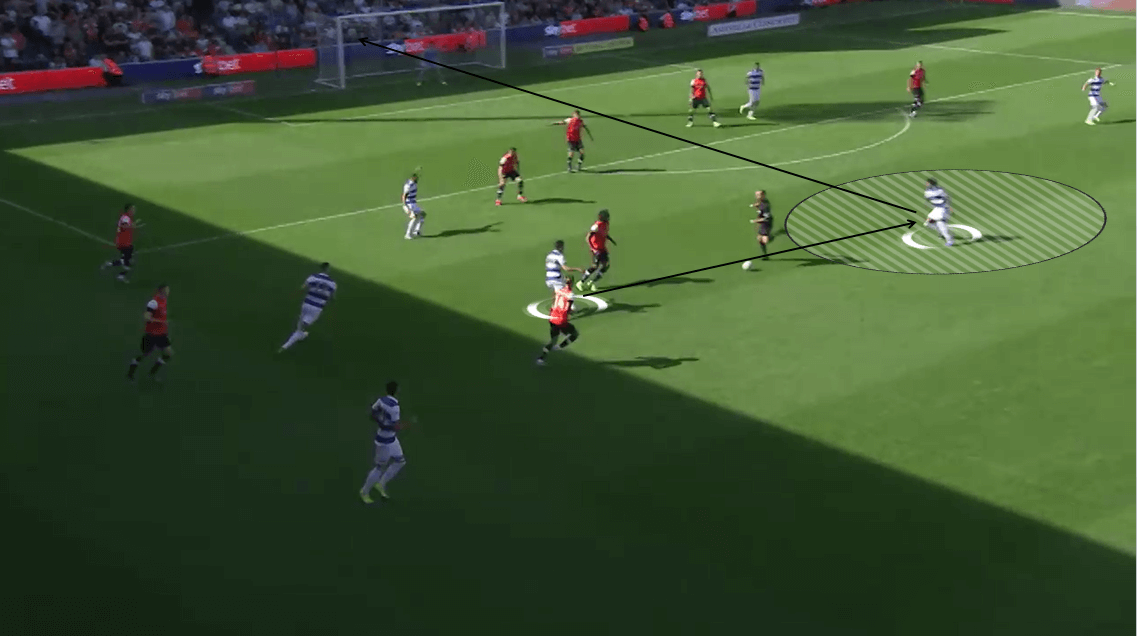
In the same match, Queens Park Rangers also exploited another major error of Luton. To allow the press high up the pitch to happen, the defensive line must push itself higher, specifically near the halfway line, and provide support for the players up front. They will take on the responsibility of intercepting through balls and long passes that head towards their half. Also, keeping a sufficient distance to allow them to retreat is another thing that the defenders have to keep in mind.
If they don’t, the opposition’s attackers will be able to sit on their shoulder and turn up at the end of those passes, which, in this case, Nahki Wells managed to capitalise that. With Luton’s defensive line kept themselves higher inside their half and stayed narrowly, the Burnley loanee managed to take on a good position to start his run. At the same time, centre-back Toni Leistner also spotted that and a perfect long ball was made into his run to allow him increased the score to 2-0.
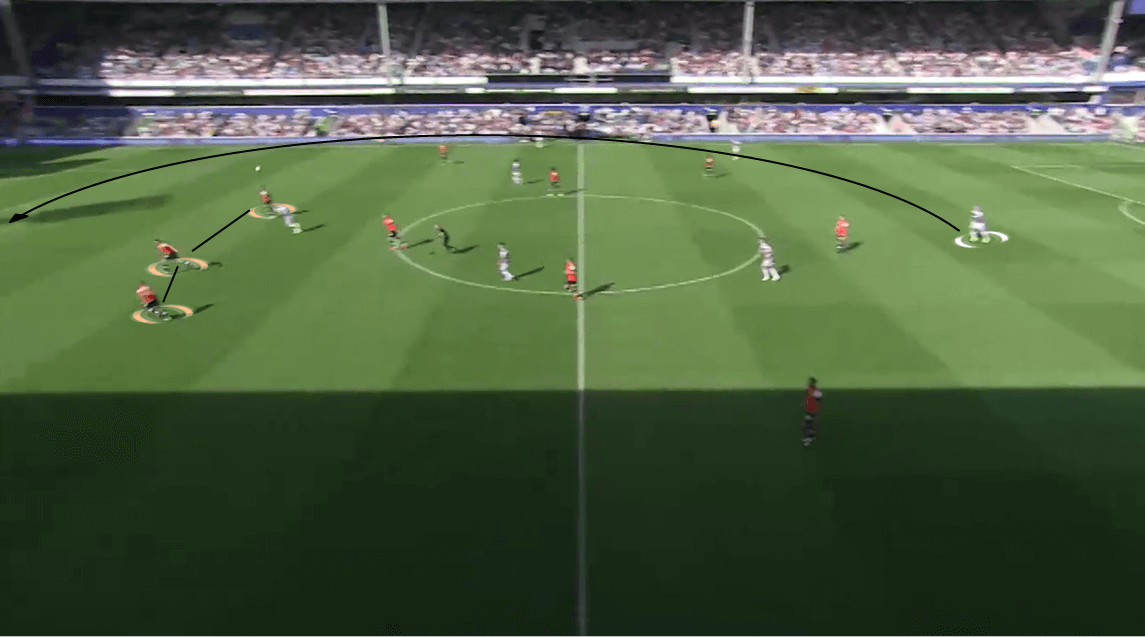
Conclusion
With 22 goals under their belt, Luton clearly have a very positive record at one end of the pitch. They started off the season quite positive and managed to pick up their form from League One, which is another good thing to consider. As their front line being led by Collins and Cornick, along with the creativity and flair from Brown, Luton shouldn’t be worrying too much about converting chances into goals, especially when the numbers are suggesting them to do worse than they are now.
But what they should be concerned about is the quality of their defending. Thirty goals conceded is a record that they must take into account while also figuring out solutions to tighten up their back-line. This contributes a lot to the fact that they drop points quite frequently this season, forcing them to involve in the relegation battle. Positive performance against Leeds United last weekend and three points against Charlton showed that they have the mentality of turning things around. It is worth keeping that momentum and mentality from now until the end of the season, along with tightening up their defence, Luton won’t be worrying about relegation in their season back in the Championship.

If you love tactical analysis, then you’ll love the digital magazines from totalfootballanalysis.com – a guaranteed 100+ pages of pure tactical analysis covering topics from the Premier League, Serie A, La Liga, Bundesliga and many, many more. Buy your copy of the November issue for just ₤4.99 here

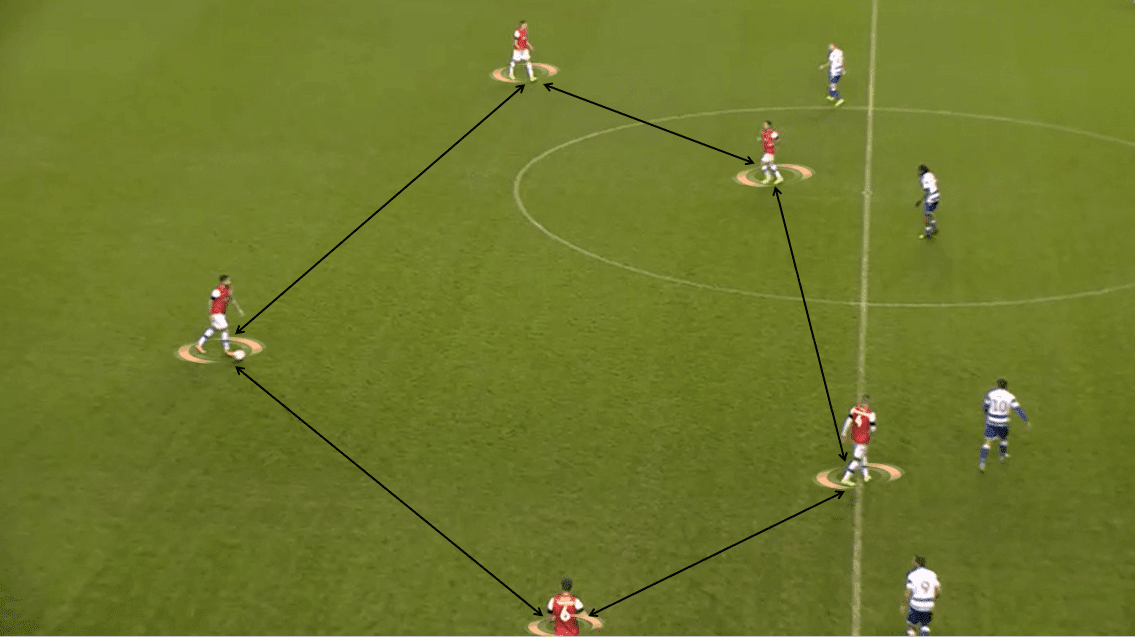


Comments